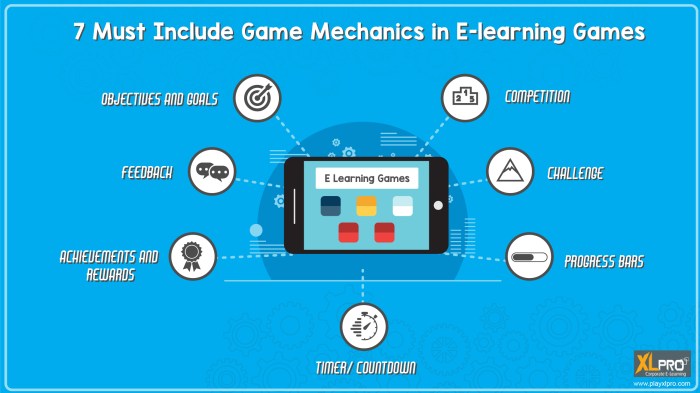Game Mechanics: They’re the hidden gears and levers that make games tick, shaping everything from simple movement to complex social interactions. This deep dive explores the core principles of game mechanics, examining how they influence player experience, drive game design, and ultimately determine whether a game is a hit or a miss. We’ll cover everything from basic combat systems to innovative reward structures, looking at how different mechanics impact player engagement, agency, and overall satisfaction.
We’ll unpack how seemingly small design choices can drastically alter a player’s journey, and how masterfully crafted mechanics can create unforgettable gaming moments. Get ready to level up your understanding of what makes a game truly great!
Core Game Mechanics

Game mechanics are the nuts and bolts of any video game, the underlying systems that dictate how players interact with the game world and each other. Understanding these mechanics is crucial for both designing engaging games and appreciating the artistry involved in their creation. They range from the seemingly simple to the incredibly complex, shaping player experience and defining genre conventions.
Fundamental game mechanics often revolve around three core pillars: movement, combat, and resource management. Movement mechanics determine how players navigate the game world, whether it’s the precise aiming of a first-person shooter or the more abstract movement of a turn-based strategy game. Combat mechanics dictate how players engage in conflict, from the real-time action of a fighting game to the strategic positioning of a turn-based RPG.
Resource management involves the acquisition, use, and allocation of in-game resources, impacting everything from character progression to base building.
Examples of Innovative Game Mechanics
Many games have pushed the boundaries of traditional game mechanics, creating unique and memorable experiences. For example,
- Portal* revolutionized puzzle-solving with its gravity-defying portals, fundamentally altering how players approached spatial challenges. Similarly,
- Minecraft*’s block-based construction system allowed for unprecedented player agency and creativity, impacting the game’s longevity and cultural influence. In the roguelike genre, games like
- Hades* have innovated by incorporating compelling narrative elements deeply interwoven with the core gameplay loop, creating a high replayability factor despite the game’s inherent permadeath mechanic. The unique “Souls-like” combat system popularized by
- Dark Souls* prioritized deliberate, strategic combat over button-mashing, shifting the focus towards skillful player execution and careful resource management.
A Novel Game Mechanic: Puzzle-Resource Synthesis
Imagine a game mechanic where players solve environmental puzzles to unlock new resource nodes. These puzzles could involve manipulating levers, activating pressure plates, or solving logic-based challenges. Solving a puzzle unlocks access to a resource node, yielding a specific type of resource (e.g., ore, crystals, energy). The type and quantity of resources gained are directly tied to the complexity of the puzzle solved.
More complex puzzles yield rarer and more valuable resources. This mechanic seamlessly integrates puzzle-solving and resource gathering, encouraging players to explore and strategize while rewarding their problem-solving skills. The difficulty of the puzzles could scale with player progression, ensuring a consistent challenge.
Comparison of Combat Systems in Action RPGs, Game Mechanics
Action RPGs often employ a variety of combat systems, each with its strengths and weaknesses. Real-time combat systems, like those in
- Diablo* or
- Path of Exile*, prioritize fast-paced action and quick reflexes. These systems are generally more accessible to new players but can sometimes feel less strategic. Turn-based combat, as seen in
Divinity
Original Sin 2*, emphasizes strategic planning and tactical positioning. While potentially slower-paced, this approach allows for more intricate combat scenarios and rewards thoughtful decision-making. Hybrid systems, like those found in
Dragon Age
Origins*, attempt to blend the best of both worlds, offering players a degree of real-time control while retaining some strategic elements. The effectiveness of each system often depends on the game’s overall design and target audience. A fast-paced action RPG might benefit from a real-time combat system, while a more narrative-driven game might prioritize a turn-based approach that allows for more character interaction and storytelling during combat.
Illustrative Examples of Game Mechanics

Game mechanics are the nuts and bolts of any video game, the underlying systems that dictate how players interact with the game world and each other. Understanding these mechanics is crucial to appreciating the design choices behind a game’s overall feel and success. This section will delve into specific examples, demonstrating how various mechanics shape the player experience.
Tetris Game Mechanics
Tetris, a seemingly simple puzzle game, relies on a surprisingly intricate set of mechanics. The core mechanic involves manipulating falling tetrominoes (geometric shapes composed of four squares) to create horizontal lines. These lines are then cleared from the playfield, awarding points and preventing the stack from reaching the top. The speed at which the tetrominoes fall increases progressively, creating a sense of urgency and escalating difficulty.
The game’s visual simplicity—the clean lines, bright colors, and instantly recognizable shapes—reinforces the focus on strategic placement and quick thinking. The player experience is one of continuous challenge, requiring both spatial reasoning and quick reflexes. The simple yet effective scoring system, tied directly to line clears, provides clear feedback and a tangible sense of progression. The “next piece” preview offers a crucial element of strategic planning, allowing players to anticipate upcoming challenges and adjust their strategy accordingly.
The game’s relentless pace and escalating difficulty create a compelling loop of challenge and reward, making it both instantly accessible and endlessly replayable.
Crafting System Visual Representation
Imagine a crafting system represented visually as a radial menu. At the center is the player character’s inventory, represented by a small icon. Branching outwards from the center are different crafting categories: weapons, armor, potions, etc., each represented by a unique icon and color. Within each category, specific craftable items are shown as smaller icons connected to their respective category.
Hovering over an item reveals a detailed tooltip displaying the required materials and the item’s stats. Materials are represented by their own small icons, with their quantities displayed numerically. A progress bar appears around the item icon as the player gathers the necessary materials, indicating completion. This radial design allows for easy navigation and clear visual feedback, allowing players to quickly assess available crafting options and their progress.
The color-coding and consistent iconography aid in intuitive understanding.
Game Mechanics by Genre
The following table categorizes examples of game mechanics by genre, highlighting their diverse applications and impact on gameplay.
| Genre | Mechanic | Description | Example Game |
|---|---|---|---|
| RPG | Skill Tree | A branching system allowing players to customize their character’s abilities and stats. | Diablo II |
| Strategy | Resource Management | Gathering and allocation of resources (e.g., gold, wood, food) to build units, structures, and upgrade technology. | StarCraft II |
| Puzzle | Match-3 | Matching three or more identical game pieces to clear them from the board. | Candy Crush Saga |
| Shooter | Cover System | Using environmental cover to avoid enemy fire and strategically reposition. | Gears of War |
General Inquiries
What’s the difference between game mechanics and game design?
Game design is the overarching process of creating a game, encompassing all aspects from concept to release. Game mechanics are the specific rules, systems, and interactions within the game that players engage with.
How do I come up with new game mechanics?
Brainstorm by combining existing mechanics, exploring different genres, and considering player psychology. Think about what makes a game fun and try to innovate on those elements.
What are some common pitfalls in game balancing?
Ignoring player feedback, focusing too much on theory and not enough on testing, and failing to account for emergent gameplay are all major pitfalls.
How important is playtesting in game mechanics development?
Crucial! Playtesting helps identify flaws, gather player feedback, and iterate on mechanics to create a balanced and enjoyable experience. It’s an iterative process.
